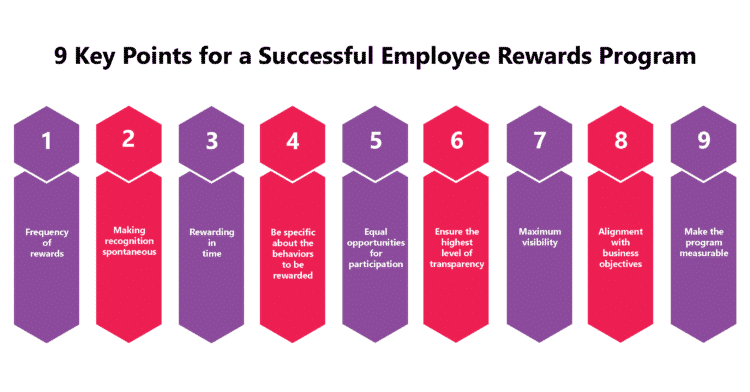What are the key elements of a successful employee recognition and rewards program?


Employee recognition and rewards programs play a crucial role in motivating and engaging employees, as well as improving their performance and retention rates. However, not all recognition and rewards programs are successful. To create an effective program, there are key elements that need to be considered. In this article, we will explore these key elements and provide valuable insights on how to design a successful employee recognition and rewards program.
1. Clear Objectives and Goals
A successful employee recognition and rewards program should have clear objectives and goals. These objectives should align with the overall organizational goals and values. By setting clear objectives, employees will understand what is expected of them and how their efforts will be recognized and rewarded. This clarity will enhance motivation and engagement among employees.
2. Timely and Specific Recognition
Recognition should be timely and specific to have a meaningful impact on employees. It is important to recognize and appreciate employees’ achievements and efforts as soon as possible. This immediate recognition reinforces positive behavior and motivates employees to continue performing at their best. Additionally, recognition should be specific, highlighting the specific actions or behaviors that led to the achievement. This specificity helps employees understand what they did well and encourages them to repeat those actions.
3. Inclusive and Fair
A successful recognition and rewards program should be inclusive and fair. It should recognize and reward employees at all levels and across different departments. This inclusivity ensures that all employees feel valued and appreciated for their contributions. Additionally, the program should be fair, with clear criteria for recognition and rewards. Employees should understand how they can earn recognition and rewards, and there should be transparency in the selection process.
4. Variety of Rewards
To cater to the diverse needs and preferences of employees, a successful program should offer a variety of rewards. Monetary rewards, such as bonuses or salary increases, are often effective motivators. However, non-monetary rewards, such as extra time off, flexible work arrangements, or personalized gifts, can also be highly valued by employees. Offering a range of rewards allows employees to choose what is most meaningful to them, increasing their satisfaction and engagement.
5. Continuous Feedback and Communication
Regular feedback and communication are essential elements of a successful recognition and rewards program. Managers should provide ongoing feedback to employees, recognizing their achievements and providing guidance for improvement. This feedback should be constructive and specific, helping employees understand their strengths and areas for development. Additionally, open communication channels should be established, allowing employees to provide feedback and suggestions for the program’s improvement.
6. Integration with Performance Management
A successful recognition and rewards program should be integrated with the organization’s performance management system. By linking recognition and rewards to performance, employees are motivated to improve their performance and achieve their goals. This integration also ensures that recognition and rewards are based on objective criteria, enhancing fairness and transparency.
7. Celebrating Milestones and Achievements
Recognizing and celebrating milestones and achievements is an important element of a successful program. Whether it’s an employee’s work anniversary, completion of a project, or reaching a significant goal, these milestones should be acknowledged and celebrated. This celebration can take the form of a team event, a personalized note, or a public announcement. Celebrating achievements not only boosts employee morale but also reinforces a culture of appreciation and recognition.
8. Continuous Improvement
A successful recognition and rewards program should be continuously evaluated and improved. Regularly gathering feedback from employees and managers can provide valuable insights into the program’s effectiveness. This feedback can be collected through surveys, focus groups, or one-on-one discussions. Based on this feedback, necessary adjustments and enhancements can be made to ensure the program remains relevant and impactful.
In conclusion, a successful employee recognition and rewards program requires careful planning and consideration of key elements. By setting clear objectives, providing timely and specific recognition, being inclusive and fair, offering a variety of rewards, providing continuous feedback and communication, integrating with performance management, celebrating milestones and achievements, and continuously improving the program, organizations can create a program that motivates, engages, and retains their employees. Such a program not only enhances employee performance but also fosters a positive and appreciative work culture.
Recent Posts
How do I create an engaging and informative online quiz or assessment?
Creating an engaging and informative online quiz or assessment can be a powerful tool for… Read More
What are the most effective methods for managing and reducing work-related stress in the hospitality industry?
Work-related stress is a common issue in the hospitality industry, where employees often face long… Read More
How can I improve my assertiveness and communication skills in a leadership position?
In a leadership position, assertiveness and effective communication skills are crucial for success. Being able… Read More
How do I effectively manage and respond to customer feedback and reviews?
Customer feedback and online reviews play a crucial role in shaping a company's reputation and… Read More
What are the best strategies for effective time management as a stay-at-home parent?
Effective time management is crucial for stay-at-home parents who juggle multiple responsibilities on a daily… Read More
How can I improve my conflict resolution skills in a team-oriented creative project?
Conflict resolution is an essential skill in any team-oriented creative project. When working collaboratively, conflicts… Read More